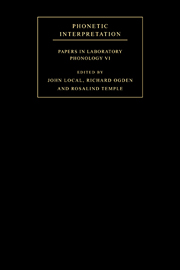Book contents
- Frontmatter
- Contents
- List of contributors
- Acknowledgements
- Introduction
- Part I Phonological representations and the lexicon
- Part II Phonetic interpretation and phrasal structure
- 6 Release the captive coda: the foot as a domain of phonetic interpretation
- 7 How many levels of phrasing? Evidence from two varieties of Italian
- 8 Domain-initial articulatory strengthening in four languages
- 9 External sandhi as gestural overlap? Counter-evidence from Sardinian
- 10 Commentary: Consonant strengthening and lengthening in various languages
- Part III Phonetic interpretation and syllable structure
- Part IV Phonology and natural speech production: tasks, contrasts and explanations
- References
- Index of names
- Index of subjects
7 - How many levels of phrasing? Evidence from two varieties of Italian
Published online by Cambridge University Press: 22 September 2009
- Frontmatter
- Contents
- List of contributors
- Acknowledgements
- Introduction
- Part I Phonological representations and the lexicon
- Part II Phonetic interpretation and phrasal structure
- 6 Release the captive coda: the foot as a domain of phonetic interpretation
- 7 How many levels of phrasing? Evidence from two varieties of Italian
- 8 Domain-initial articulatory strengthening in four languages
- 9 External sandhi as gestural overlap? Counter-evidence from Sardinian
- 10 Commentary: Consonant strengthening and lengthening in various languages
- Part III Phonetic interpretation and syllable structure
- Part IV Phonology and natural speech production: tasks, contrasts and explanations
- References
- Index of names
- Index of subjects
Summary
Introduction
Evidence for prosodic structure above the word generally stems from two sources. On one hand, tonal phenomena, such as boundary tones and pitch accent association, have been shown to define edges and heads of prosodic domains, such as the intermediate phrase (Pierrehumbert and Beckman 1988), in a variety of languages, including English, German and Italian. On the other hand, Prosodic Phonology has mainly employed segmental sandhi phenomena at word boundaries to motivate phonological constituency. In this framework, what provides the information for the prosodic constituent to be built is surface syntactic structure (Selkirk 1984; Kaisse 1985; Nespor and Vogel 1986). At levels above the word, Prosodic Phonology posits a hierarchy of ‘phrasing’ levels, which are not necessarily overlapping with syntactic constituents and are domains for specific phonological rules. Independent of the specific version of the theory one adopts, the most generally assumed constituents above the word are the phonological phrase (ϕ) and the Intonational phrase (I).
Regardless of the specific diagnostic employed for the definition of prosodic domains, the fundamental question remains of how many levels of phrasing we need to assume in the prosodic analysis of a specific language. In Italian, while a number of proposals have been advanced regarding the metrical structure of subword constituents, such as the syllable and the mora (Repetti 1991; Nespor 1993), uncontroversial proposals regarding the status of larger units are still missing. Most research has limited its investigation to the role of external sandhi phenomena in defining some of these constituents.
- Type
- Chapter
- Information
- Phonetic InterpretationPapers in Laboratory Phonology VI, pp. 130 - 144Publisher: Cambridge University PressPrint publication year: 2004

